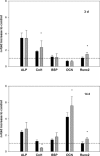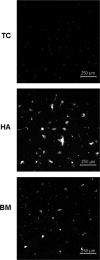Calcium phosphate surfaces promote osteogenic differentiation of mesenchymal stem cells
- PMID: 18366455
- PMCID: PMC3823489
- DOI: 10.1111/j.1582-4934.2007.00103.x
Calcium phosphate surfaces promote osteogenic differentiation of mesenchymal stem cells
Abstract
Although studies in vivo revealed promising results in bone regeneration after implantation of scaffolds together with osteogenic progenitor cells, basic questions remain how material surfaces control the biology of mesenchymal stem cells (MSC). We used human MSC derived from bone marrow and studied the osteogenic differentiation on calcium phosphate surfaces. In osteogenic differentiation medium MSC differentiated to osteoblasts on hydroxyapatite and BONITmatrix, a degradable xerogel composite, within 14 days. Cells revealed a higher alkaline phosphatase (ALP) activity and increased RNA expression of collagen I and osteocalcin using real-time RTPCR compared with cells on tissue culture plastic. To test whether material surface characteristics alone are able to stimulate osteogenic differentiation, MSC were cultured on the materials in expansion medium without soluble additives for osteogenic differentiation. Indeed, cells on calcium phosphate without osteogenic differentiation additives developed to osteoblasts as shown by increased ALP activity and expression of osteogenic genes, which was not the case on tissue culture plastic. Because we reasoned that the stimulating effect on osteogenesis by calcium phosphate surfaces depends on an altered cell-extracellular matrix interaction we studied the dynamic behaviour of focal adhesions using cells transfected with GFP labelled vinculin. On BONITmatrix, an increased mobility of focal adhesions was observed compared with cells on tissue culture plastic. In conclusion, calcium phosphate surfaces are able to drive MSC to osteoblasts in the absence of osteogenic differentiation supplements in the medium. An altered dynamic behaviour of focal adhesions on calcium phosphate surfaces might be involved in the molecular mechanisms which promote osteogenic differentiation.
Figures








Similar articles
-
Scaffold preferences of mesenchymal stromal cells and adipose-derived stem cells from green fluorescent protein transgenic mice influence the tissue engineering of bone.Br J Oral Maxillofac Surg. 2014 May;52(5):409-14. doi: 10.1016/j.bjoms.2014.02.023. Epub 2014 Mar 27. Br J Oral Maxillofac Surg. 2014. PMID: 24685477
-
Influence of platelet-rich plasma on osteogenic differentiation of mesenchymal stem cells and ectopic bone formation in calcium phosphate ceramics.Cells Tissues Organs. 2006;183(2):68-79. doi: 10.1159/000095511. Cells Tissues Organs. 2006. PMID: 17053323
-
Ectopic bone formation associated with mesenchymal stem cells in a resorbable calcium deficient hydroxyapatite carrier.Biomaterials. 2005 Oct;26(29):5879-89. doi: 10.1016/j.biomaterials.2005.03.001. Biomaterials. 2005. PMID: 15913762
-
Modifications in Gene Expression in the Process of Osteoblastic Differentiation of Multipotent Bone Marrow-Derived Human Mesenchymal Stem Cells Induced by a Novel Osteoinductive Porous Medical-Grade 3D-Printed Poly(ε-caprolactone)/β-tricalcium Phosphate Composite.Int J Mol Sci. 2021 Oct 18;22(20):11216. doi: 10.3390/ijms222011216. Int J Mol Sci. 2021. PMID: 34681873 Free PMC article.
-
Effects of different physical factors on osteogenic differentiation.Biochimie. 2023 Apr;207:62-74. doi: 10.1016/j.biochi.2022.10.020. Epub 2022 Nov 3. Biochimie. 2023. PMID: 36336107 Review.
Cited by
-
Assessment of the effect of silica calcium phosphate nanocomposite on mesenchymal stromal cell differentiation and bone regeneration in critical size defect.Saudi Dent J. 2021 Dec;33(8):1119-1125. doi: 10.1016/j.sdentj.2021.03.008. Epub 2021 Apr 1. Saudi Dent J. 2021. PMID: 34938057 Free PMC article.
-
Positive impact of dynamic seeding of mesenchymal stem cells on bone-like biodegradable scaffolds with increased content of calcium phosphate nanoparticles.Mol Biol Rep. 2019 Aug;46(4):4483-4500. doi: 10.1007/s11033-019-04903-7. Epub 2019 Jun 10. Mol Biol Rep. 2019. PMID: 31183678
-
The material and biological characteristics of osteoinductive calcium phosphate ceramics.Regen Biomater. 2018 Feb;5(1):43-59. doi: 10.1093/rb/rbx024. Epub 2017 Sep 8. Regen Biomater. 2018. PMID: 29423267 Free PMC article. Review.
-
Influence of Human Jaw Periosteal Cells Seeded β-Tricalcium Phosphate Scaffolds on Blood Coagulation.Int J Mol Sci. 2021 Sep 14;22(18):9942. doi: 10.3390/ijms22189942. Int J Mol Sci. 2021. PMID: 34576103 Free PMC article.
-
Combined macromolecule biomaterials together with fluid shear stress promote the osteogenic differentiation capacity of equine adipose-derived mesenchymal stem cells.Stem Cell Res Ther. 2021 Feb 12;12(1):116. doi: 10.1186/s13287-021-02146-7. Stem Cell Res Ther. 2021. PMID: 33579348 Free PMC article.
References
-
- Salgado AJ, Coutinho OP, Reis RL. Bone tissue engineering: state of the art and future trends. Macromol Biosc. 2004;4:743–65. - PubMed
-
- Pountos I, Jones E, Tzioupis C, McGonagle D, Giannoudis PV. Growing bone and cartilage. The role of mesenchymal stem cells. J Bone Joint Surg Br. 2006;88:421–6. - PubMed
-
- Petite H, Viateau V, Bensaid W, Meunier A, De Pollak C, Bourguignon M, Oudina K, Sedel L, Guillemin G. Tissue-engineered bone regeneration. Nat Biotechnol. 2000;18:959–63. - PubMed
-
- Mistry AS, Mikos AG. Tissue engineering strategies for bone regeneration. Adv Biochem Eng Biotechnol. 2005;94:1–22. - PubMed
Publication types
MeSH terms
Substances
LinkOut - more resources
Full Text Sources
Other Literature Sources
Miscellaneous

